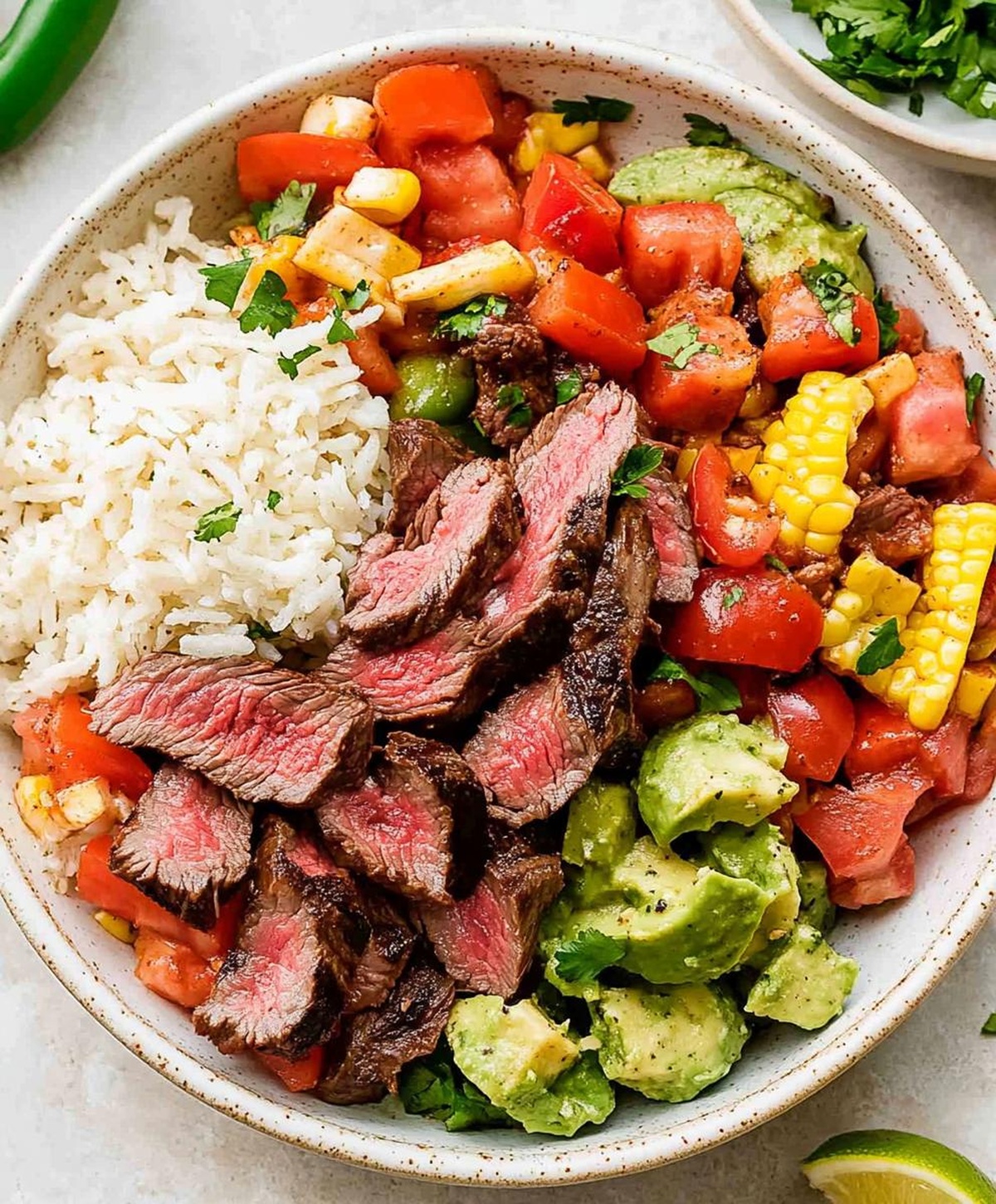Sizzling High Protein Steak Fajita Bowl Recipe for Hearty Meals
Steak sizzles with vibrant peppers in this high protein steak fajita bowl recipe that promises a flavor explosion.
Tender slices of marinated beef dance alongside colorful bell peppers and onions.
Each bite delivers a perfect balance of protein-packed goodness and zesty southwestern spices.
Crisp vegetables add a fresh crunch to the hearty meat base.
Quinoa or rice creates a satisfying foundation for this delicious meal.
Simple ingredients combine to create a restaurant-worthy dish you can quickly prepare at home.
This bowl transforms weeknight dinner into a delectable culinary adventure that will have everyone asking for seconds.
Steak Fajita Bowl with a High Protein Boost
Ingredients for a Steak Fajita Bowl
Protein Source:Vegetables:Marinade and Seasoning:Cooking Oils:Simple Steps for Building Fajita Bowls
Step 1: Craft Zesty Marinade for Steak
Mix together chipotle peppers in adobo sauce, avocado oil, lime juice, and cumin in a mixing bowl.
Thoroughly coat the skirt steak with this spicy mixture.
Refrigerate the marinated steak overnight to enhance flavor depth.
Remove from refrigerator 30 minutes before cooking to bring to room temperature.
Step 2: Roast Colorful Vegetables
Preheat oven to 400°F.
Slice ingredients:Spread vegetable strips on a sheet pan.
Drizzle with avocado oil.
Sprinkle with:Toss vegetables to ensure even coating.
Roast for 15-20 minutes until tender and slightly caramelized.
Step 3: Sauté Cauliflower Rice
Heat skillet with avocado oil over medium heat.
Add riced cauliflower and cook, stirring occasionally.
Aim for a light golden color, which takes about 15 minutes.
Season with salt and pepper.
Transfer to a covered bowl to keep warm.
Step 4: Sear Steak to Perfection
Remove excess marinade from steak.
Heat skillet to medium-high with avocado oil.
Cook steak 2-3 minutes per side, targeting medium-rare at 130°F.
Let steak rest on cutting board for 5 minutes.
Slice thinly against the grain to maintain juiciness.
Step 5: Build Delicious Protein Bowls
Layer ingredients in serving bowls:Serve immediately while ingredients are hot and flavors are vibrant.
Tips for Juicy Steak and Bold Flavor
Storage Tips for Fajita Bowls
What Goes Well with Steak Fajita Bowls
Bowl Variations to Try
FAQs
Yes, you can substitute skirt steak with flank steak or sirloin. Just adjust cooking time based on the thickness of the meat to ensure proper doneness.
While riced cauliflower adds a low-carb base, you can replace it with brown rice, quinoa, or cauliflower rice from the store if you prefer. Each option will slightly change the nutritional profile.
Add more chipotle peppers in adobo sauce during marination or sprinkle some red pepper flakes on top. You can also include a dash of hot sauce when assembling the bowl for extra heat.
Olive oil works perfectly as a substitute. Both have similar cooking properties and can withstand medium-high heat needed for searing the steak.
Print
High Protein Steak Fajita Bowl Recipe
- Total Time: 1 hour 55 minutes
- Yield: 4 1x
Description
Sizzling Mexican-inspired Steak Fajita Bowl delivers bold southwestern flavors packed with protein and zesty spices. Colorful peppers, tender beef, and cilantro-lime rice create a delicious meal that satisfies your craving for robust, balanced cuisine.
Ingredients
Main Protein:
- 1 pound (454 grams) skirt steak
Marinade Ingredients:
- 2 tablespoons chipotle peppers in adobo sauce (finely chopped) with sauce
- 2 tablespoons avocado or olive oil
- 2 tablespoons fresh lime juice
- 1.5 teaspoons cumin
- Salt
- Pepper
Vegetable and Supporting Ingredients:
- 0.5 tablespoon avocado or olive oil
- 1 10-ounce (283 grams) bag riced cauliflower
- 0.5 tablespoon avocado oil
- 1 red bell pepper, sliced
- 0.5 yellow onion, sliced
- 0.5 teaspoon cumin
Instructions
- Craft a vibrant marinade by blending chipotle peppers, oil, lime juice, and cumin in a mixing bowl. Thoroughly coat the skirt steak, ensuring complete coverage. Refrigerate for optimal flavor infusion, allowing at least 30 minutes for marination. Remove from refrigerator 30 minutes before cooking to reach room temperature.
- Preheat oven to 400F. Slice red bell peppers and yellow onions into thin strips. Arrange on a sheet pan, drizzle with oil, and season with salt, pepper, and cumin. Toss to distribute seasonings evenly. Roast for 15-20 minutes until vegetables reach desired tenderness.
- Heat oil in a large skillet over medium heat. Add riced cauliflower, stirring occasionally to prevent sticking. Cook for approximately 15 minutes until lightly golden. Season with salt and pepper. Transfer to a covered bowl to maintain warmth.
- Remove excess marinade from steak. Heat skillet to medium-high, adding fresh oil. Sear steak for 2-3 minutes per side, targeting a medium-rare temperature of 130F. Allow steak to rest for 5 minutes, then slice thinly against the grain to preserve juiciness.
- Compose the fajita bowls by layering riced cauliflower as a base. Top with roasted bell peppers and onions. Arrange sliced steak over the vegetables. Serve immediately while ingredients remain warm, creating a protein-rich, flavor-packed meal.
Notes
- Marinate overnight for maximum flavor infusion, allowing the chipotle and lime to deeply penetrate the steak’s fibers.
- Use a meat thermometer to precisely check the steak’s internal temperature, ensuring consistent doneness every time.
- Swap skirt steak with flank or sirloin for different texture variations while maintaining high protein content.
- For low-carb or keto dieters, replace cauliflower rice with extra roasted vegetables or additional protein to reduce carbohydrate intake.
- Prep Time: 1 hour 15 minutes
- Cook Time: 40 minutes
- Category: Lunch, Dinner
- Method: Roasting
- Cuisine: Mexican
Nutrition
- Serving Size: 4
- Calories: 400
- Sugar: 3g
- Sodium: 600mg
- Fat: 28g
- Saturated Fat: 5g
- Unsaturated Fat: 20g
- Trans Fat: 0g
- Carbohydrates: 12g
- Fiber: 4g
- Protein: 30g
- Cholesterol: 80mg


Clara Thompson
Recipe Developer & Culinary Educator
Expertise
Developing accessible single-serving recipes, Food writing and content creation, Plant-based and allergen-friendly cooking, Culinary education and workshop facilitation
Education
Oregon Culinary Institute (Portland, OR)
Diploma in Culinary Arts
Specialized in plant-based cooking and sustainable kitchen practices.
Portland Community College
Certificate in Food Writing and Media
Focused on recipe writing, food photography, and digital content creation.
Clara’s food journey began with a curiosity for color, texture, and ingredients pulled straight from the garden. Her background in plant-forward cooking and creative writing gives her a unique edge – she makes healthy, flavorful food feel inviting, not intimidating.
She specializes in meals that work for busy lives and different diets, all without sacrificing taste. Clara’s voice comes through in every recipe she writes – clear, kind, and encouraging.